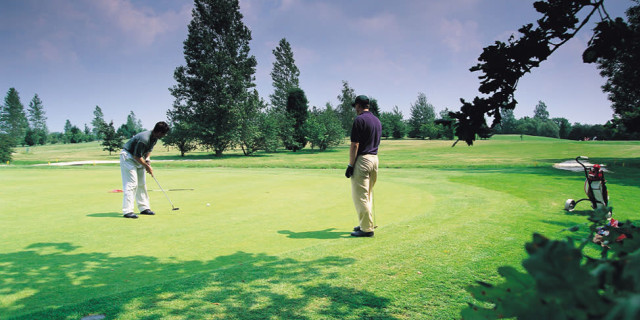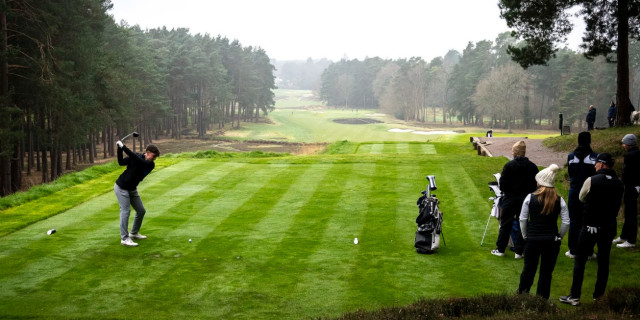
Are Fewer People Playing Golf in the UK?
Answer the Golfshake 2019 Survey!
In April, Tiger Woods won The Masters in dramatic and emotional circumstances. Many described it as the greatest sporting comeback of all time. In July, Shane Lowry won The Open Championship in thrilling fashion at Royal Portrush - tickets for the event in Northern Ireland were sold out months in advance. It is the first time that has ever happened.
So all is well in the world of British golf then? Not quite.
The success of national sporting teams in football, cricket, rugby and tennis is reflected directly by increased numbers of children and adults either taking up those sports for the first time or returning to them. Even though Eddie Jones’ England team were beaten by South Africa in Yokohama, the RFU is expecting to see significant numbers of new players of all ages and the pieces are already in place to help and encourage youngsters who want to try the game for the first time.
Formula One is a different kettle of fish. Lewis Hamilton’s sixth world title will lead to more young boys dreaming of following in his footsteps but unless they have wealthy parents they will struggle to fulfil their hopes.
It may also be more than a coincidence that football, cricket, rugby union and Formula One dominate the sports pages of the national and regional media, as well as on websites with huge followings - do you know anybody who doesn’t check out BBC Sport on a regular basis?
What about golf? You already know the answer to that.

Despite Tiger’s glorious victory, despite Lowry’s heroics and despite Europe’s unbelievable performance in winning the Ryder Cup at Le Golf National in 2018, playing numbers continue to dwindle. And the only time that the media shows any real interest is for four majors and that Ryder Cup - and remember that it is only played once every two years.
As for women’s golf, it is almost as if the press are embarrassed to cover it. The Women’s British Open, which is one of the sport’s majors, is lucky to get one piece per day during its four rounds. Anybody who watched Georgia Hall win at Royal Lytham in 2018 will find that hard to believe. She was sensational - and she is British, for goodness sake.
In the likes of McIlroy, Tommy Fleetwood, Ian Poulter, Paul Casey and Justin Rose we have some of the best players in the world. But they don’t really capture the public’s imagination, and that can only be because our sport receives next to no mainstream TV coverage. Unless you subscribe to Sky Sports, you simply are not going to have the chance to be thrilled by the exploits of these incredible athletes. And if young boys and girls don’t have the opportunity to see them then they will not want to emulate them.
KPMG has just released its annual Golf Participation Report, and it makes for fascinating reading.
The report looks at participation throughout Europe which, as a whole, has actually experienced a significant growth in demand and supply since the 1980s. Overall, the number of players has trebled in the past 25 years, with the number of courses doubling in the same period. With the well-publicised course closures in Britain, you may find this somewhat puzzling but remember that there has been a huge upsurge in countries such as Turkey, which is now seen as a genuine rival to destinations such as Spain and Portugal, where many more new courses have opened as they aim for the lucrative tourist market.
Astonishingly, the number of courses in England and Scotland has actually increased since 2015. At the end of 2018, there were 1,888 courses in England, an increase of 2% on 2015. It should be noted that this figure will now have fallen given all the closures reported this year. In Scotland there were 560 courses at the end of 2018, up from 545 in 2015. Ireland lost 19 courses, while seven closed their doors for the last time in Wales.
From 2000 to 2010, England and Wales experienced a decrease in the number of golfers (-63,800 and -14,500, respectively), and numbers continue to fall. Germany saw a 74% growth while, incredibly, numbers of players in Holland increased by a staggering 146% and by 124% in Spain.

Since 2015, participation numbers in England have fallen from 678,372 in 2015 to 645,151, a fall of 4.8%; in Ireland, it has fallen from 194,151 in 2015 to 182,298, down 6%; in Wales, the numbers have plummeted by a frightening 13%, from 49,084 to 42,743. And even in Scotland, the home of golf, the trend is the same, with a 10% fall, from 199,764 club members in 2015 to 180,281 in 2018. Since 2010, the number of active club members has fallen from 1,369,500 to 1,050,573. That is a fall of, wait for it, 23%. And the trend shows no sign of slowing down.
According to KPMG, the overall participation rate for Europe has remained pretty stable since 2015. In fact, when taking a closer look at Europe’s golf markets, 54.5% of local golf associations indicated that the level of participation in their country in 2018 had either stabilised or increased. The remaining 45.5% of European markets experienced some decline, including England and Scotland.
And despite the best efforts of everybody involved with the game, it continues to be dominated by men. On average, 65% of all golfers are men, 25% are women and 10% are junior golfers. In the UK and Ireland, which is by far Europe’s largest golf market, 75% of players are male. It would be all too easy for us to shrug our shoulders and accept that’s just the way it is, but some countries are doing something right. Turkey has an extensive youth programme, the Golf Junior League initiative, and it works. Over the past three years more than 2,000 new junior golfers were registered in the country.
There is little doubt that uncertainty over Brexit and the economic downturn have had an impact on playing numbers throughout Europe in general and in the UK in particular. People who are worried about the future, who fear that their jobs may be at risk, are looking at ways to save money, and giving up their golf-club membership is any easy saving to make.

Last year there was a 4% decrease in the number of golf club members in the UK and Ireland. KPMG believes that tour pros such as McIlroy, Rickie Fowler and Francesco Molinari are bringing a fresh, reinvigorated outlook to the professional game, which is also being supported by the inclusion of golf in the Olympics. This overlooks the fact that McIlroy and many of his high-profile colleagues boycotted the last Olympics.
It seems pretty obvious to say that governments, tourism bodies, golf federations and associations have a crucial role to play in encouraging the industry to join forces, for the good of the game.
Everybody agrees that more needs to be done to attract women and children, but golf’s stakeholders seem to be incapable of agreeing how to achieve this. Is it really so difficult to get the game into schools? Why don’t golf clubs realise that making their facilities more family friendly might actually help them to attract women and children?
It is also interesting to note that although club membership is no longer a growing area, huge numbers of “nomadic” golfers remain happy to pay as they play, using websites such as Golfshake to identify courses where they will be made welcome. These are men and women who don’t necessarily want to play every week and see no point in forking out in the region of £1,000 for an annual subscription. They are also people who, in the main, just don’t want to be dragged into the politics that seem to go hand in hand with life at the average golf club. They want to have fun and they want some choice. And what on earth is wrong with wanting to have a bit of fun?
What are your views on the game and where it's at? Share your thoughts in the Golfshake 2019 Survey!
Related Article
Is This How We Grow The Game of Golf?
How to Increase Golf Club Memberships
Survey Highlights Opportunities for Golf Clubs to Increase Revenue
How Technology & Digital Platforms Can Benefit Golf
What Stops Golfers Joining Clubs?
About the author

Derek Clements is a seasoned sports journalist and regular Golfshake contributor, specialising in tour coverage, opinion pieces, and feature writing. With a long career in national newspapers and golf media, he has reported on the game across Europe, the United States and Australia. A passionate golfer, he has played and reviewed numerous renowned courses, with personal favourites including Pebble Beach, Kingsbarns, Aldeburgh, Old Thorns and the K Club. His love of the game informs his thoughtful commentary on both professional golf and the wider golfing community.
Tags: Survey slow play rules Memberships junior golf industry insider Grow Game golfshake Golf Clubs daily picks










